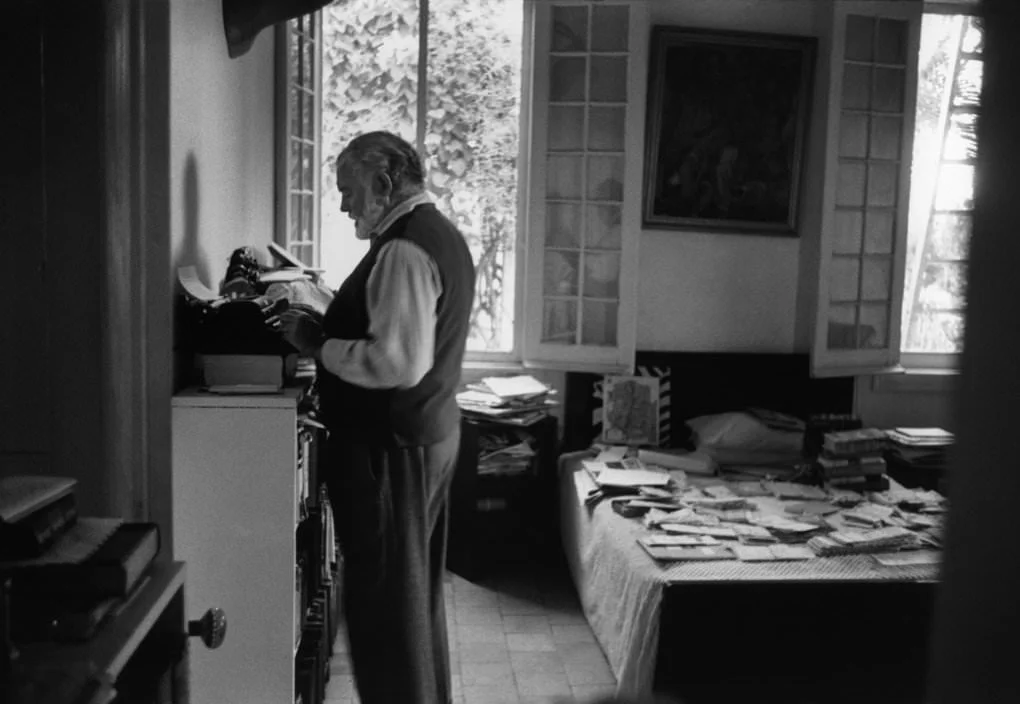
Kierkegaard apparently did his best writing standing up, as did Charles Dickens, Winston Churchill, Vladimir Nabokov and Virginia Woolf. Also put Ernest Hemingway in the standing desk club too.
In 1954, George Plimpton interviewed Hemingway for the literary journal he co-founded the year before, The Paris Review. The interview came prefaced with a description of the novelist’s writing studio in Cuba:
Ernest Hemingway writes in the bedroom of his house in the Havana suburb of San Francisco de Paula. He has a special workroom prepared for him in a square tower at the southwest corner of the house, but prefers to work in his bedroom, climbing to the tower room only when “characters” drive him up there…
The room is divided into two alcoves by a pair of chest-high bookcases that stand out into the room at right angles from opposite walls.…
It is on the top of one of these cluttered bookcases—the one against the wall by the east window and three feet or so from his bed—that Hemingway has his “work desk”—a square foot of cramped area hemmed in by books on one side and on the other by a newspaper-covered heap of papers, manuscripts, and pamphlets. There is just enough space left on top of the bookcase for a typewriter, surmounted by a wooden reading board, five or six pencils, and a chunk of copper ore to weight down papers when the wind blows in from the east window.
A working habit he has had from the beginning, Hemingway stands when he writes. He stands in a pair of his oversized loafers on the worn skin of a lesser kudu—the typewriter and the reading board chest-high opposite him.
Popular Science, a magazine with roots much older than the Paris Review, first began writing about the virtues of standing desks for writers back in 1883. By 1967, they were explaining how to fashion a desk with simple supplies instead of forking over $800 for a commercial model — a hefty sum in the 60s, let alone now. Plywood, saw, hammer, nails, glue, varnish — that’s all you need to build a DIY stand-up desk. Or, as Papa Hemingway did, you could simply throw your writing machine on the nearest bookcase and get going. As for how to write the great American novel, I’m not sure that Popular Science offers much help. But maybe some advice from Hemingway himself will steer you in the right direction. See Seven Tips From Ernest Hemingway on How to Write Fiction.
For more on the benefits of the standing desk, see this post from the Harvard Business Review.
If you would like to sign up for Open Culture’s free email newsletter, please find it here. Or follow our posts on Threads, Facebook, BlueSky or Mastodon.
If you would like to support the mission of Open Culture, consider making a donation to our site. It’s hard to rely 100% on ads, and your contributions will help us continue providing the best free cultural and educational materials to learners everywhere. You can contribute through PayPal, Patreon, and Venmo (@openculture). Thanks!


and Victor Hugo too ! while Albert Einstein worked at a standing desk as well…
We could also join the Portuguese poet Fernando Pessoa to the club. Here I leave a link to the photo of the high chest of drawers where he used to write, standing as he preferred.
gogol as well :)
Philip Roth.
Donald Rumsfeld. So they can be used for evil, too.
Thomas Wolfe
And Thomas Wolfe, who had the same editor.
Philip Roth, too, I believe.
ok… I’m standing on my desk…nnn…but nothing’s happening??
Nabokov, too.
(Oops…I see Nabby’s been included)
Johann Wolfgang von Goethe!
I prefer to write lying down
How extraordinary!
I thought that I had personally invented this strange way of authoring.
However, it was through forced circumstance, being forced to write in many strange places, cramped and pestered by people and things, the nearest bureau would be forced into service while I diligently exercised cramped leg muscles from my usual thousands of miles of air travel, in order to mitigate the possibility of blood clots in the legs.
And we all know what a paragon of healthy habits Hemingway was…
Perhaps this is what drove him to suicide!?
Open Culture, you could much improve this image of Hemingway by using Photoshop or other photo software to brighten it, which will bring out details now too dark to distinguish – very simple. Which I did before printing out to hang on wall in front of me at standing up desk.
Rilke too — in case he wasn’t mentioned.
Absurd.